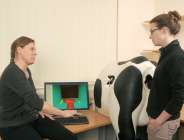Virtual reality cow simulator goes global

A virtual reality cow, invented by a University of Bristol graduate, will soon be used to educate future vets around the world.
Professor Sarah Baillie (BVSc 1986 and BSc 1984), who has recently returned to the University as Chair in Veterinary Education at the School of Veterinary Sciences, combined her veterinary knowledge with computer science to create the Haptic Cow while studying for a PhD at Glasgow University.
The revolutionary Haptic Cow allows students to carry out virtual examinations of the cow using a touch-feedback device that mimics the feeling of a real bovine anatomy, placed inside a fibreglass model of a cow's rear end.
Professor Baillie's creation is used by veterinary schools across the country and will now be marketed to an international audience to help train the vets of the future.
Students reach inside a black and white fibreglass shell and connect to a specially designed robotic arm. Students are able to see simplified representations of various structures, such as ovaries, on a separate screen and this is matched by what they can 'feel' in the simulator.
The teacher can then provide instruction and feedback while following the student's hand movements inside the cow on the computer monitor.
Professor Baillie came up with the idea for the virtual cow several years ago, after an injury forced her to leave veterinary practice and retrain in computer science. She'd spent years trying to teach students how to palpate cows on the farm, so when she learned about touch-feedback technology that could simulate the feel of 3D objects, she recognised a perfect opportunity to blend her two careers.
She developed the Haptic Cow while studying for a PhD at the University of Glasgow and has also developed other animals including a Haptic Horse for equine colic simulation. The current model uses a touch feedback device from SensAble Technologies, hooked up to a computer that's programmed to deliver just the right amount of force in response to a student's touch.
Instructors can also set up different scenarios to help students learn the difference between the soft sensation of a healthy pregnant uterus and the firmer, doughier feel of an infected animal.
Professor Baillie said: "The virtual environment of the Haptic Cow simulates the bovine reproductive tract, including models of the cervix, uterus and ovaries with a wide range of fertility cases, pregnancies and some examples of pathology.
"The concept has proven very popular and students find it really useful because they can see what they're doing on a screen and receive guidance from their instructor. It's great to be able to offer it as a learning aid to international vet schools too."
The Haptic Cow has also proved to be a great success as a public engagement tool, giving prospective students an insight into studying veterinary science at Open Days and enabling youngsters to have a hands-on experience at the Science Museum in London and at the Discover festival - the University of Bristol's public celebration of its research.
It will be a central feature of a haptic simulation workshop which the School of Veterinary Sciences is running for local school children as part of a Wellcome Trust People Award project led by Professor Baillie.
Provided by University of Bristol



















